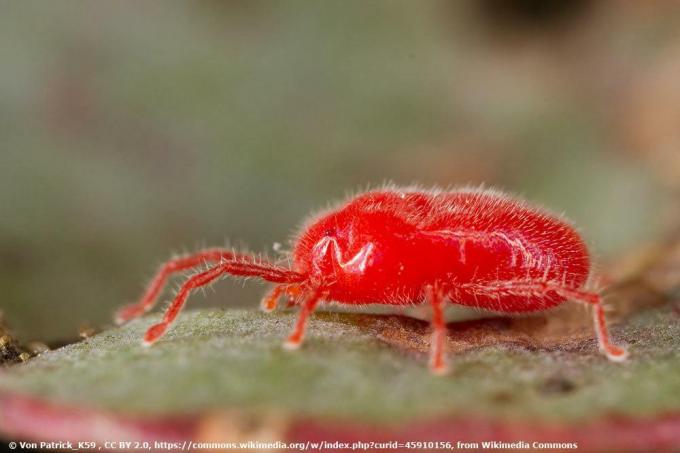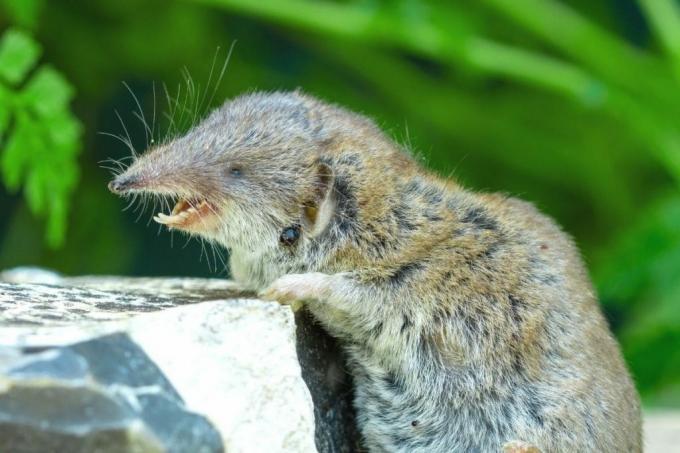
table of contents
- Pests with many names
- Recognize grass mites
- The paper trick
- Fight grass mites
- frequently asked Questions
Do you have itchy bites on your legs after spending time in the garden? Grass mites can be the culprit. We show you how to protect yourself and your pets and how to fight grass mites.
In a nutshell
- Grass mites belong to the arachnid family
- live on the lymphatic fluid of humans and animals
- Bites cause severe itching and red hives
- Grass mites appear on grass surfaces from spring to autumn
- Natural home remedies help with prevention
Pests with many names
Grass mites (Neotrombicula autumnalis) are the pests of summer. They have many names:
- Hay mites
- Autumn grass mites
- Grass lice
- Harvest mites
However, the term "Herbstbeiß" fits best.
Recognize grass mites
The two millimeter large animals are barely visible to the naked eye. They live in the ground and lay their eggs in the grass. The larvae hatch from June to July. They sit on blades of grass and wait for their victims. Pets that roam the meadows and people who walk barefoot or are only wearing sandals are at risk.
The mites crawl up the legs and look for a thin-skinned, moist, warm part of the body. The hollows of the knees, belly button, lower legs, ankles and armpits are often affected. After the bite, the insects give off a secretion which softens the top layer of cells. Then they can suck in lymph, cell fluid and even blood unhindered.
At first, the bite goes unnoticed. Red dots only become visible several hours later. Severe itching occurs after 24 hours.

Note: Symptoms usually go away in a day or two. However, sensitive people can react violently to the bite of an autumn grass mite. If blisters form or the pain doesn't go away, see a doctor.
The paper trick
Autumn grass mite larvae only reach about 0.3 millimeters in length. Use the paper trick to identify an infestation in the lawn:
- Take a sheet of white paper.
- Put it on your lawn on a dry, sunny day.
- If you see small red dots on the white paper, it is grass mite larvae.
Fight grass mites
We have put together natural home remedies and tips with which you can fight grass mites and make them more difficult to settle on the lawn in the garden. A complete elimination of the pests is not possible.
- Mow your lawn frequently. Keep the grass short. Dispose of the grass clippings in the organic waste bin. In this way you can significantly reduce the number of feared larvae.
- Scarify the lawn regularly to remove the moss, because autumn grass mites like to stay there too.
- Moisturize your lawns. Grass mites prefer drought. In the event of rain or artificial irrigation, the larvae withdraw into the ground.
- Fight mice on your property. Mice are considered to be carriers of the mites.
- Strengthen your lawn in spring by applying a lime-nitrogen fertilizer. Mow the lawn and apply the fertilizer on a dry day.
- Water the grassy areas with a neem oil-water solution. To do this, add 100 milliliters of neem oil to five liters of water and spray the lawn with it.
- Maintain a distance of at least two meters between lawns and the house to prevent people from migrating into the apartment.

Note: Cold winters naturally reduce autumn grass mites. The small animals can retreat up to half a meter deep into the ground, but if the frost penetrates that far, they have no chance of surviving. However, as warm winters increase in Central Europe, the number of mites is increasing.
frequently asked Questions
Autumn grass mites are not pests, so there are no pesticides available to control them. Make use of the presented options and natural home remedies. Protect yourself with appropriate clothing.
Cool and disinfect the affected areas. Try not to scratch.
The main season for grass mites begins in July and does not end until October.
In the summer, wear shoes and stockings when you walk across meadows or when you are in the garden or in the swimming pool on a lawn. Take a shower immediately afterwards to rinse off the insect larvae.
If dogs and cats are constantly licking and scratching each other, mite bites can be the cause. They prefer the warm, moist, less hairy parts of the body of pets. Shower your dog after walking across meadows and fields. Frequent washing of animal blankets will help control grass mites. Contact the veterinarian if symptoms persist a few days after the grass mite bites.
